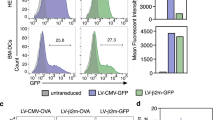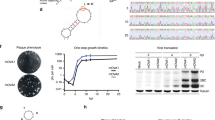Abstract
Human immunodeficiency virus-1-derived lentiviral vectors have been increasingly used for gene delivery in both pre-clinical and clinical models. Numerous studies have shown that dendritic cells (DC) transduced with concentrated lentiviral vectors can induce primary T-cell responses to viral and tumor antigens. In this study, we attempted to generate influenza hemagglutinin-specific CD4 T cells using lentiviral vectors containing the signal sequence and human lysosome-associated membrane protein to target hemagglutinin to the major histocompatibility complex class II processing pathway. Autologous dendritic cells were generated in serum-free medium and transduced with concentrated, high-titer lentiviruses to stimulate autologous T cells. Unexpectedly, we failed to generate influenza hemagglutinin-specific CD4 T cells rather than T cells specific for fetal calf serum (FCS). By limiting dilution, we established several FCS-specific CD4 T-cell clones restricted by human leukocyte antigen-DR1 and human leukocyte antigen-DR4. Lentiviruses produced in human serum-adapted 293 cells or in serum-free medium were unable to sensitize dendritic cells for recognition by FCS-specific CD4 T-cell clones. Our results indicate that residual FCS in concentrated lentiviral pellets is, in part, responsible for its immunogenicity. These FCS-specific CD4 T cells may be useful in testing clinical grade lentiviral vectors for the presence of contaminating FCS.
This is a preview of subscription content, access via your institution
Access options
Subscribe to this journal
Receive 12 print issues and online access
$259.00 per year
only $21.58 per issue
Buy this article
- Purchase on Springer Link
- Instant access to full article PDF
Prices may be subject to local taxes which are calculated during checkout






Similar content being viewed by others
References
Kordower JH, Emborg ME, Bloch J, Ma SY, Chu Y, Leventhal L et al. Neurodegeneration. Science 2000; 290: 767–773.
Consiglio A, Quattrini A, Martino S, Bensadoun JC, Dolcetta D, Trojani A et al. In vivo gene therapy of metachromatic leukodystrophy by lentiviral vectors: correction of neuropathology and protection against learning impairments in affected mice. Nat Med 2001; 7: 310–316.
Azzouz M, Le T, Ralph GS, Walmsley L, Monani UR, Lee DC et al. Lentivector-mediated SMN replacement in a mouse model of spinal muscular atrophy. J Clin Invest 2004; 114: 1726–1731.
Levine BL, Humeau LM, Boyer J, MacGregor RR, Rebello T, Lu X et al. Gene transfer in humans using a conditionally replicating lentiviral vector. Proc Natl Acad Sci USA 2006; 103: 17372–17377.
Naldini L, Blomer U, Gage FH, Trono D, Verma IM . Efficient transfer, integration, and sustained long-term expression of the transgene in adult rat brains injected with a lentiviral vector. Proc Natl Acad Sci USA 1996; 93: 11382–11388.
Naldini L, Blomer U, Gallay P, Ory D, Mulligan R, Gage FH et al. In vivo gene delivery and stable transduction of nondividing cells by a lentiviral vector. Science 1996; 272: 263–267.
Saenz DT, Poeschla EM . FIV: from lentivirus to lentivector. J Gene Med 2004; 6: S95–104.
Blomer U, Naldini L, Kafri T, Trono D, Verma IM, Gage FH . Highly efficient and sustained gene transfer in adult neurons with a lentivirus vector. J Virol 1997; 71: 6641–6649.
Dull T, Zufferey R, Kelly M, Mandel RJ, Nguyen M, Trono D et al. A third- generation lentivirus vector with a conditional packaging system. J Virol 1998; 72: 8463–8471.
Zufferey R, Nagy D, Mandel RJ, Naldini L, Trono D . Multiply attenuated lentiviral vector achieves efficient gene delivery in vivo. Nat Biotech 1997; 15: 871–875.
Zufferey R, Dull T, Mandel RJ, Bukovsky A, Quiroz D, Naldini L et al. Self-inactivating lentivirus vector for safe and efficient in vivo gene delivery. J Virol 1998; 72: 9873–9880.
van Lunzen J, Glaunsinger T, Stahmer I, von Baehr V, Baum C, Schilz A et al. Transfer of autologous gene-modified T cells in HIV-infected patients with advanced immunodeficiency and drug-resistant virus. Mol Ther 2007; 15: 1024–1033.
Gruber A, Kan-Mitchell J, Kuhen KL, Mukai T, Wong-Staal F . Dendritic cells transduced by multiply deleted HIV-1 vectors exhibit normal phenotypes and functions and elicit an HIV-specific cytotoxic T-lymphocyte response in vitro. Blood 2000; 96: 1327–1333.
Dyall J, Latouche J-B, Schnell S, Sadelain M . Lentivirus-transduced human monocyte-derived dendritic cells efficiently stimulate antigen-specific cytotoxic T lymphocytes. Blood 2001; 97: 114–121.
Firat H, Zennou V, Garcia-Pons F, Ginhoux F, Cochet M, Danos O et al. Use of a lentiviral flap vector for induction of CTL immunity against melanoma. Perspectives for immunotherapy. J Gene Med 2002; 4: 38–45.
Breckpot K, Dullaers M, Bonehill A, Van Meirvenne S, Heirman C, De Greef C et al. Lentivirally transduced dendritic cells as a tool for cancer immunotherapy. J Gene Med 2003; 5: 654–667.
Lizee G, Gonzales MI, Topalian SL . Lentivirus vector-mediated expression of tumor-associated epitopes by human antigen presenting cells. Hum Gene Ther 2004; 15: 393–404.
Chen X, Wang B, Chang L-J . Induction of primary anti-HIV CD4 and CD8 T cell responses by dendritic cells transduced with self-inactivating lentiviral vectors. Cell Immunol 2006; 243: 10–18.
Breckpot K, Aerts JL, Thielemans K . Lentiviral vectors for cancer immunotherapy: transforming infectious particles into therapeutics. Gene Therapy 2007; 14: 847–862.
Wu TC, Guarnieri FG, Staveley-O’Carroll KF, Viscidi RP, Levitsky HI, Hedrick L et al. Engineering an intracellular pathway for major histocompatibility complex class II presentation of antigens. Proc Natl Acad Sci USA 1995; 92: 11671–11675.
Riddell SR, Elliott M, Lewinsohn DA, Gilbert MJ, Wilson L, Manley SA et al. T-cell mediated rejection of gene-modified HIV-specific cytotoxic T lymphocytes in HIV-infected patients. Nat Med 1996; 2: 216–223.
Bonini C, Ferrari G, Verzeletti S, Servida P, Zappone E, Ruggieri L et al. HSV-TK gene transfer into donor lymphocytes for control of allogeneic graft-versus-leukemia. Science 1997; 276: 1719–1724.
Selvaggi TA, Walker RE, Fleisher TA . Development of antibodies to fetal calf serum with arthus-like reactions in human immunodeficiency virus-infected patients given syngeneic lymphocyte infusions. Blood 1997; 89: 776–779.
Tuschong L, Soenen SL, Blaese RM, Candotti F, Muul LM . Immune response to fetal calf serum by two adenosine deaminase-deficient patients after T cell gene therapy. Hum Gene Ther 2002; 13: 1605–1610.
Mackensen A, Drager R, Schlesier M, Mertelsmann R, Lindemann A . Presence of IgE antibodies to bovine serum albumin in a patient developing anaphylaxis after vaccination with human peptide-pulsed dendritic cells. Cancer Immunol Immunother 2000; 49: 152–156.
Baekelandt V, Claeys A, Eggermont K, Lauwers E, De Strooper B, Nuttin B et al. Characterization of lentiviral vector-mediated gene transfer in adult mouse brain. Hum Gene Ther 2002; 13: 841–853.
Baekelandt V, Eggermont K, Michiels M, Nuttin B, Debyser Z . Optimized lentiviral vector production and purification procedure prevents immune response after transduction of mouse brain. Gene Therapy 2003; 10: 1933–1940.
Wang RF, Wang X, Atwood AC, Topalian SL, Rosenberg SA . Cloning genes encoding MHC class II-restricted antigens: mutated CDC27 as a tumor antigen. Science 1999; 284: 1351–1354.
Amendola M, Venneri MA, Biffi A, Vigna E, Naldini L . Coordinate dual-gene transgenesis by lentiviral vectors carrying synthetic bidirectional promoters. Nat Biotechnol 2005; 23: 108–116.
Zhou X, Cui Y, Huang X, Yu Z, Thomas AM, Ye Z et al. Lentivirus-mediated gene transfer and expression in established human tumor antigen-specific cytotoxic T cells and primary unstimulated T cells. Hum Gene Ther 2003; 14: 1089–1105.
Tiscornia G, Singer O, Verma IM . Production and purification of lentiviral vectors. Nat Protocols 2006; 1: 241–245.
Riddell SR, Greenberg PD . The use of anti-CD3 and anti-CD28 monoclonal antibodies to clone and expand human antigen-specific T cells. J Immunol Methods 1990; 128: 189–201.
Acknowledgements
We are grateful to Dr Nikunj Somia for helpful discussion on lentiviral purification and Dr Nicola Philpott for English editing. LB was a recipient of a Baxter Oncology Postdoctoral Fellowship of the Amy Strelzer Manasevit Scholars Program, the National Marrow Donor Program. XZ was a recipient of an American Society of Hematology Junior Faculty Award. This work was supported by the Children's Cancer Research Fund in Minneapolis, Viking Children's Fund and the University of Minnesota Masonic Cancer Center (XZ). LB and HG designed, carried out the research, analyzed the data and wrote the paper; XH, ST and MW designed, carried out the research, analyzed the data and edited the paper; RSM discussed the work and wrote the paper; XZ oversaw the work and wrote the paper.
Author information
Authors and Affiliations
Corresponding author
Rights and permissions
About this article
Cite this article
Bao, L., Guo, H., Huang, X. et al. High-titer lentiviral vectors stimulate fetal calf serum-specific human CD4 T-cell responses: implications in human gene therapy. Gene Ther 16, 788–795 (2009). https://doi.org/10.1038/gt.2009.34
Received:
Revised:
Accepted:
Published:
Issue Date:
DOI: https://doi.org/10.1038/gt.2009.34



